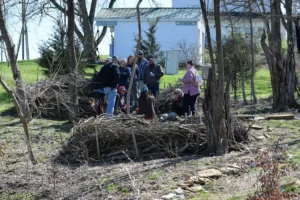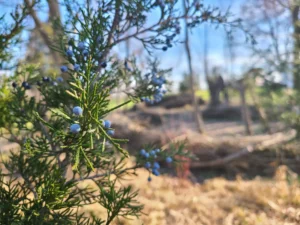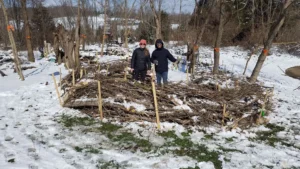Metamorpho-Nest enters its winter slumber…or does it?
Although Metamorpho-Nest may appear to be sleeping in winter, it still serves a vital purpose for the ecosystem at JSP. Stems, foliage, and limbs within the plant beds and nests of this area provide cozy critter condos for a variety of wildlife during this restful season.
The nests, made up of branches of invasive honeysuckle, may be used for shelter by a variety of birds, mammals, reptiles, amphibians and insects. Overtime, the decaying wood will also bring insects for birds and small mammals and give nutrients back to the soil beneath. The rocks in Ditto Grove also provide hiding places and shelter for invertebrates and amphibia.

Visitors learn about plants inside Metamorpho-Nest by Andrea Wilson Mueller of Inside Out Landscape Design.
The brown color of dead foliage that would stand out as a blemish in spring and summer now provides essential shelter and food for over-wintering wildlife. Winter homes are particularly important for beneficial insects, who either overwinter themselves or use plant material to nest eggs for the following season. Beneficial insects specifically are vital to our ecosystem because many of them hatch just in time to keep aphids and other pests in check. Insects, including butterflies and moths, use dead canes from woody plants in the nests and hollowed out stems from perennials. Even the stems of smaller wildflowers and grasses are useful to insects for overwintering, in particular small stem-nesting bees.
In addition to shelter, Metamorpho-Nest provides food in winter. The seed heads of coneflower and Joe Pye Weed can remain standing tall through winter, providing continued food for year-round wildlife. The evergreen Eastern White Pine becomes a star in winter, providing both shelter for large birds such as owls and even eagles as well as providing highly nutritious seeds favored by smaller birds, squirrels, rabbits, and other animals. The deciduous trees provide shelter as well, in the form of peeling bark, hollowed out areas, and leaf debris.

The Eastern Red-Cedar’s blue/purple cones contain seeds that are a great food source for birds.
When the snow falls, these plant remnants and nests offer visual and physical texture against the white blanket of winter to please the human population as well. A visit to Metamorpho-Nest this time of year provides a glimpse into the importance of a winter slumber for landscapes. Like with humans, these cycles of life are a necessary part of survival.
We live through different stages within our lives with transformations and awakenings – like the caterpillar that becomes a butterfly or moth or the plant that goes dormant and comes back for many seasons throughout many years. Soon Metamorpho-Nest will come full circle. The once newly planted and small trees will continue to develop as they emerge once again. The soil too will change overtime, as well as the nest material itself. Stay tuned for the stirrings of spring as this living sculpture comes to life once again.

Metamorpho-Nest in its early stages in March 2022.